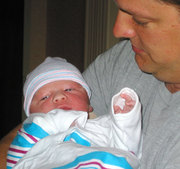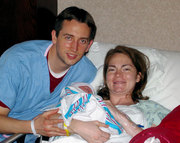Earlier, I made the (crazy? rediculous?) claim that Apple is actually aiming for a world where you will buy their (excellent) hardware and run whatever program you want on it. In this installment, I will attempt to explain exactly why I think this is inevitable and what some of the repercussions will be.
Like a judo master working against a slower opponent, Apple has slowly been putting in place the technical foundation that will let them be the (and not the current “a) preferred platform for workstation computing during the next decade. The move to a stable (if slow) version of BSD as the core of their operating system, the move to Intel-based chipsets, the push into consumer electronics like the iPod that are largely neutral to the computing platform of the end user, the ties made with the creative content makers (both corporate and smaller), all of these moves and more have put them into an excellent position to do what consumers really want a personal computer to do: let them do whatever they need to do on a computer using whatever software tool they want on a single, easy-to-use device. And the biggest obstacle Apple faces is that, currently, people cannot run Windows-based applications on their Mac in an easy way. Apple is embarking on a journey that will make that happen.
There have been a lot of attempts to allow users to run Windows-based applications without Windows. Probably the biggest is WINE, an open-source Quixote-like effort to allow Linux/Unix users to run Windows-based apps without an installation of Windows, essentially trying to copy the functionality of Windows DLLs and their APIs. However, despite years of effort and some pretty big names behind it, WINE never really took off, since it trailed the development of Windows (like trying to hit a moving target) and was constantly measured based on its variable compatibility with the most used Windows apps. Darwin, the open-source core of Mac OS X, has had its own WINE effort, called Darwine, underway for years, with little to show for it. However, these largely failed efforts have not escaped the imagination of Steve Jobs, and I’m sure that his inner circle noticed one important thing about WINE: If the user has the real Windows DLLs on their system (not the attempts by WINE to emulate them, but the real thing), WINE actually works great.
I expect that, either in the next major release of Mac OS X or the one after that, Apple will support running Windows in several different ways. You will be able to boot into Windows natively (which will probably only be necessary for certain games and industrial applications), boot Windows in a full virtual environment that will let you run Windows apps at native speed within a private Windows memory space, or (the default) you can just run your Windows application right on your Mac, just like it was written for Mac OS X.
I think that Tevanian left because there was an internal struggle at Apple when they realized what was possible, with Tevanian in one camp thinking that allowing Windows apps to run on Macs will kill Mac OS X development and Jobs in the other camp thinking that developers, when given the choice, will actually prefer making their applications on Mac OS X instead of Windows over time, especially when Apple comes to own 30% or more of the PC market. On this one, the boss got his way, and Tevanian stepped aside. Now, geeks are already running specialized versions of Windows XP (Media Center Edition and Tablet PC to name two) on Macs, and virtualization will bring the billions spent by Microsoft on R&D over the past decade into a competitor’s environment, running side-by-side. Once that the majority of the home PC market gets a taste of life on Mac OS X, there is a chance they will prefer it. They will gladly pay the Microsoft Tax for Windows and Apple’s high hardware prices for something that just works.
There have been a lot of rumors that Apple will sell a version of Mac OS X for Intel PCs that will not require Apple hardware. Those people have been smoking crack. What I do expect is for Apple to consider releasing an emulation layer that will let Mac OS X applications to run on XP and Vista. Why would Apple want to mess with the horrors of PC hardware drivers and configuration disasters? Let Microsoft worry about that stuff. As long as Microsoft collects their OEM tax from PC makers and the PC still leaves running Windows, Microsoft will be happy (at least for a while). But this is down the road, so I will leave this thread as something for you to ponder.
To the consumer, Apple will be known as the company where you can select from simple options to buy a computer, and that computer will be able to run just about any application you want. The computer may cost a little bit more than Dell or HP, but it will be well-made, look cool, and perform well on whatever you want to do. Since the Mac will not, by default, boot a full Windows environment but just use the installed Windows DLLs to allow Windows apps to work, most Windows viruses/spyware/malware will not work – most of these depend on a full version of Windows to operate, and the full version of Windows will not be running. Instead, I expect a microkernel written by Apple to broker the connection to the Windows DLLs, and it will protect users from bad things that Windows software will want to do. The consumer won’t see any of this, though. All they know is that don’t have to buy antivirus software (for Windows) or run Windows Update every 3 minutes or rebuild their system every 6 months to wipe off all of the junk.
But what does this mean for PC makers like Dell and HP? They will be fine. Corporate IT will largely ignore this development, and they will continue to pump tens of billions every quarter into traditional PC purchases, which will not (at least at first) be able to run Mac OS X apps. Apple will grow quite a bit and claim a lot more of the PC share, but it will probably be at the expense of smaller PC makers.
What about Mac OS X applications? Are they doomed? Probably not. After all, users will still have to pay for Windows if they want to run Windows apps. Over time, with more users being in a position to buy Mac OS X native apps, users will probably do so, especially if they only run 1 or 2 Windows apps. Apple will make running Windows possible but not as desirable as running only the Mac OS. You have to remember that Apple has some experience with doing this. Anyone remember the Classic environment running in Mac OS X? They were able to cajole millions of their users into the environment they wanted, even though a lot of those users were happy with the old environment. The move away from Windows will take a long time, possibly a decade, but the steps are in place.
Apple will become a computer company known for flexibility, which is ironic, considering their history of maintaining such as a strong grip of control on their hardware and operating systems.
Think it’s a pipe dream? Time will tell. Please feel free to comment…

